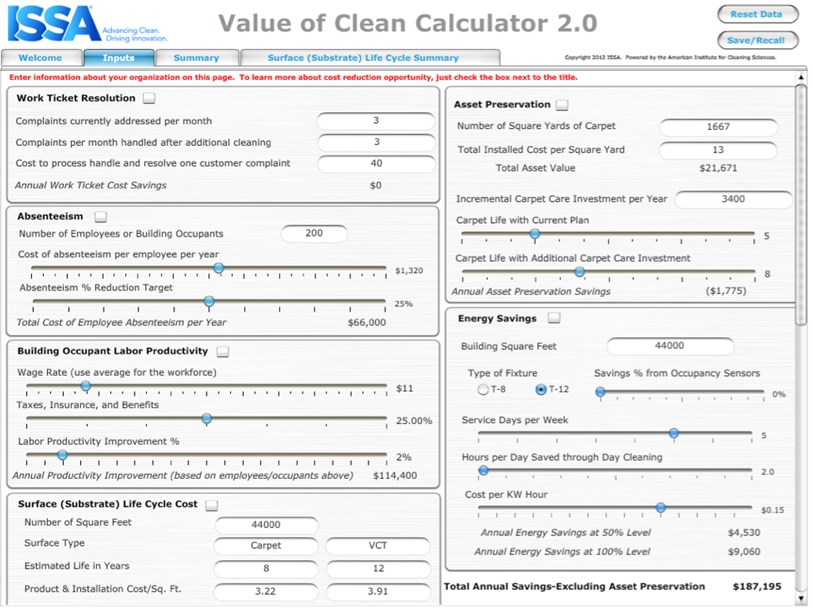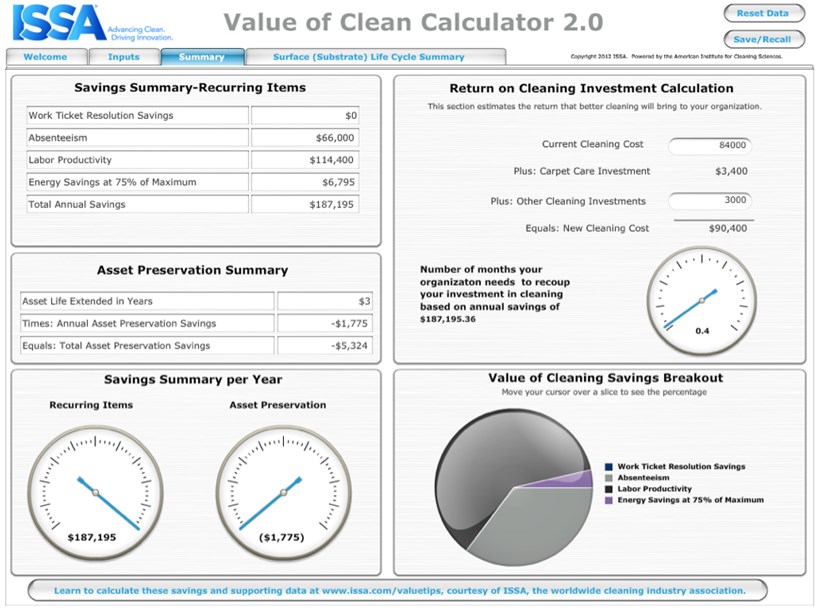by Jamie Harris — A frog can sit in a pot of hot water and not notice the temperature rise to boiling until it is too late. Many of us in the cleaning industry need to stop behaving similarly. We cannot ignore the fact that the changes—such as staff and budget reductions— occurring in our industry may well be permanent. If we ignore them, by the time we wake up, we will be boiled (out of business). If you doubt this statement consider the following snippet of fact.
In 1968, Forbes magazine selected the 10 then most profitable U.S. companies in terms of equity, growth, and five-year performance. By 1985, three of them no longer even existed as independent companies. In fact, one of the three was in bankruptcy. Four others had returns on equity that barely rivaled bank certificates.
This is not meant to scare anyone, but rather, to encourage all of us to embrace the changes and be glad we have resources like the ISSA Value of Clean Tool kit to help us grow and improve our businesses.
Calculated Value
In the article “Achieving Excellence,” which appears on the American Institute for Cleaning Science, (AICS) Web site, AICS President Dave Frank writes “Success depends on making sure that the framework is capable of fostering effective and consistent results.” The Value of Clean is a vital tool in building and sustaining this framework.
Being a Cleaning Industry management Standard (CIMS) assessor, I am privileged to interact with the “best of the best” cleaning contractors on a frequent basis. They have built their framework using the CIMS and CIMS-Green Building standards for operational excellence. On each and every assessment, business development call, or consulting work I do with my customers now, I introduce and use The Value of Clean concept. The responses have been positive but varied based on their knowledge and specific needs. However, to help better explain the specific benefits of the calculator, I will stick to the following, one real-life example.
Recently, I was asked to assist a 44,000-square-foot, financial institution that was having problems with its contracted cleaning company. The issue, in management’s mind, was (1) the company’s boss did not care, (2) the turnover was too high, (3) there was no follow up to complaints, (4) they were skipping areas they were contracted to clean, etc. I asked to look at the Scope of Work and frequencies of services. I did not want to know what they were paying or even the name of the cleaning company, because I planned to use The Value of Clean Calculator 2.0 as my tool to help.
First, since they called me as a consultant and not to bid as a contractor I had a unique opportunity to interview managers to gather the information I needed to plug into the calculator. The managers shared all the information necessary except Cost per Work Ticket, as they did not track this statistic currently. They were interested in it, though, and wanted to know a benchmark of what other businesses Cost per Work Ticket spent and said they should start tracking this number. I reviewed the components and shared the number provided from the Value of Clean white paper that work tickets could cost an average of US$13 to $49 each. Exhibit 1 and Exhibit 2 are screen shots of the Value of Clean I performed for them as a sample.
As a side note, I have shown some of the companies I have assessed for CIMS how to fill out the Value calculator modules and how to get ballpark estimates from sources, such as the power company, internet studies, and their own experiences if they don’t have hard numbers. I also asked this customer for permission to provide a High Touch Areas bid as outlined in the white paper, usually reserved for hospitals. In my experience in the hospitality industry, using my ATP luminometer, many of the same high-touch areas and the same principles can—and should be—applied to all our customers.
One of my all-time favorite authors is Peter Drucker, and I use this quote from him all the time: “Quality in a service or product is not what you put into it. It is what the client or customer gets out of it.” If we do not ask our customers to take it a step further than they may have anticipated, how will they know there is a better way to approach their situation or have the chance to say yes to the improvement? In this case, because I had the right tools to gain the managers confidence, I had an opportunity to leverage their interest in improvement and also provide a second bid with a more traditional scope.
Life Cycling
Next, during this interview, I learned the company was just about to start a major renovation. This provided an excellent opportunity to discuss Life Cycle Costing for flooring, because these numbers were close at hand. I used the numbers in Exhibit 3 from The Value of Clean presentation.
This analysis of surfaces and the proper cleaning approach to extend their assets’ life cycle provided a smooth transition into discussing—and the client agreeing—to clean the carpets more often. In all, my discussions with property managers, general managers, and facility managers regarding this component of The Value of Clean Calculator has garnered the most interest. With all of the third-party data provided and their need to save money, they have all understood and appreciated the value, and in two cases wanted to increase their cleaning frequency even more than suggested!
I know some people can be suspicious of new tools, especially if they look like they require additional work. But I’ve seen direct improvements when taking these extra steps with customers. I’ve created an Executive Summary of my customer experiences thus far with the Value of Clean elements and ranked the areas where I have received the most feedback and interest. Your rankings may be different, and I hope they are because each customer will have different hot buttons—which is why I’m so pleased with the multiple angles the Value of Clean Toolkit offers. This allows us to tailor the strongest message to each customer for the best results. I hope you’ll find this report valuable and that it encourages you to implement parts of the Value of Clean Toolkit with your customers because we need to get the message out and start changing the perception of our value.
Executive Summary:
Below are the categories covered, my ranking in terms of importance to my customers, and my notes on elements from the ISSA Value of Clean Calculator 2.0 and the ISSA Value of Clean white paper:
- Asset Preservation. I usually cover this section in-depth because I have Total Facilities Management and Reserve Study background and am very comfortable discussing this in great detail. If a company is doing or considering renovation, this allows the cleaning contractor to be involved in materials choice and leads to greater investment in cleaning than originally anticipated.
- Image Enhancement. This was actually in the ISSA Value of Clean white paper. This ties into customer satisfaction, which makes it a high priority with those I’ve discussed it with to date.
- Occupant Wellness: Absenteeism. Customers were very interested and ready to discuss this value area.
- Occupant Wellness: Improved Productivity. I have not used this as much as Absenteeism to date.
- Energy Savings. This should be #1 when a customer is doing all night cleaning and it’s possible to switch to day cleaning. It at least can provide opportunity to provide day porter services.
- Reducing Hospital Associated Infections. I have applied this information and the supporting principles to commercial buildings/hotels/resorts, so it has transferable value to other customer segments.
I did not rank Work Ticket Resolution costs since my customers had yet not used this. But as a consultant, I see this as offering a great opportunity to help customers learn to track these costs better going forward.
Just because everyone does not immediately embrace all the great new ideas we bring forth, we need not despair. Sometimes it takes time for a new product or idea to develop a following. For instance, the Coca-Cola Co. sold just 400 cokes in its first year. Yes, you read correctly, just 400 bottles! I see the Value of Clean tools as something similar. It may take a while to figure out the best way to use the right modules to expand customer thinking and gain greater buy-in for proper cleaning, but my initial experiences are proving that it’s worth the effort. “Drink a coke, don’t get boiled, and try a new approach” is my new motto for why we should use the tools in ISSA’s new Value of Clean Tool kit. They’re the next big thing our industry has been waiting for!


